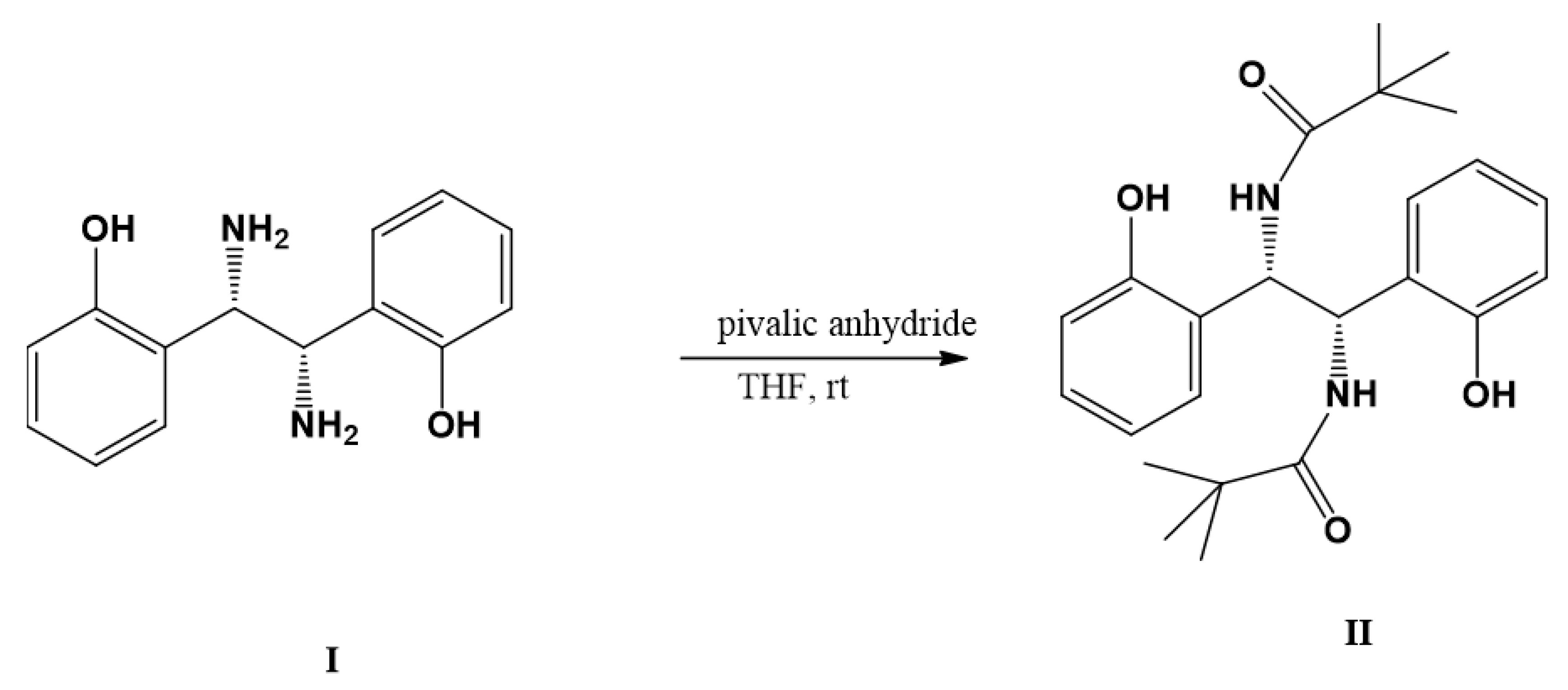1-[(1S,2S)-1,2-Bis(2-hydroxyphenyl)-2-pivaloylaminoethylamino]-2,2-dimethyl-1-propanone
Abstract
:1. Introduction
2. Results and Discussion
3. Experimental
Supplementary Materials
Funding
Conflicts of Interest
References
- Olson, V.R.; Feldman, H. Quantitative Acetylation of Amines by Means of Acetyl Chloride and Pyridine. J. Am. Chem. Soc. 1937, 59, 2003–2005. [Google Scholar] [CrossRef]
- Romanelli, G.P.; Bennardi, D.O.; Autino, J.C.; Baronetti, G.T.; Thomas, H.J. A Simple and Mild Acylation of Alcohols, Phenols, Amine, and Thiols with a Reusable Heteropoly Acid Catalyst (H6P2W18O62·24H2O). E-J. Chem. 2008, 5, 641–647. [Google Scholar] [CrossRef]
- Chakraborti, A.K.; Gulhane, R.; Shivani. Copper (II) Tetrafluoroborate-Catalyzed Acetylation of Phenols, Thiols, Alcohols, and Amines. Synthesis 2004, 111–115. [Google Scholar] [CrossRef]
- Kadam, S.T.; Kim, S.S. Phosphomolybdic Acid: Mild and Efficient Catalyst for Acetylation of Alcohols, Phenols, and Amines under Solvent-Free Conditions. Synthesis 2008, 267–268. [Google Scholar] [CrossRef]
- Reddy, T.S.; Narasimhulu, M.; Suryakiran, N.; ChinniMahesh, K.; Ashalatha, K.; Venkateswarlu, Y. A mild and efficient acetylation of alcohols, phenols and amines with acetic anhydride using La(NO3)3·6H2O as a catalyst under solvent-free conditions. Tetr. Lett. 2006, 47, 6825–6829. [Google Scholar] [CrossRef]
- Kanta De, S. Ruthenium (III) chloride catalyzed acylation of alcohols, phenols, thiols, and amines. Tetr. Lett. 2004, 45, 2919–2922. [Google Scholar] [CrossRef]
- Das, B.; Thirupathi, P. A highly selective and efficient acetylation of alcohols and amines with acetic anhydride using NaHSO4·SiO2 as a heterogeneous catalyst. J. Mol. Catal. A Chem. 2007, 269, 12–16. [Google Scholar] [CrossRef]
- Aerry, S.; Kumar, A.; Saxena, A.; De, A.; Mozumdar, S. Chemoselective Acetylation of Amines and Thiols Using Monodispersed Ni-nanoparticles. Green Chem. Let. Rev. 2013, 6, 183–188. [Google Scholar] [CrossRef]
- Basu, K.; Chakraborty, S.; Sarkar, A.K.; Saha, C. Efficient Acetylation of Primary Amines and Amino acids in Environmentally Benign Solution Using Acetyl Chloride. J. Chem. Sci. 2013, 125, 607–613. [Google Scholar] [CrossRef]
- Qiu, R.; Zhu, Y.; Xu, X.; Li, Y.; Shao, L.; Ren, X.; Cai, X.; An, D.; Yin, S. Zirconocene bis(perfluorooctanesulfonate)s-catalyzed acylation of alcohols, phenols, thiols, and amines under solvent-free conditions. Catal. Commun. 2009, 10, 1889–1892. [Google Scholar] [CrossRef]
- Satam, J.R.; Jayaram, R.V. Acetylation of Alcohols, Phenols and Amines Using Ammonium Salt of 1,2-tungstophosphoric Acid: Environmentally Benign Method. Catal. Commun. 2008, 9, 2365–2370. [Google Scholar] [CrossRef]
- Naik, S.; Bhattacharjya, G.; Talukdar, B.; Patel, B.K. Chemoselective Acylation of Amines in Aqueous Media. Eur. J. Org. Chem. 2004, 1254–1260. [Google Scholar] [CrossRef]
- Stevenson, R.J.; Denny, W.A.; Tercel, M.; Pruijn, F.B.; Ashoorzadeh, A. Nitro seco analogues of the duocarmycins containing sulfonate leaving groups as hypoxia-activated prodrugs for cancer therapy. J. Med. Chem. 2012, 55, 2780–2802. [Google Scholar] [CrossRef] [PubMed]
- Ljevaković, D.; Tomić, S.; Tomasić, J. Selective pivaloylation of 2-acetamido-2-deoxy sugars. Carbohyd. Res. 1988, 182, 197–205. [Google Scholar] [CrossRef]
- González, F.S.; García, J.I.; Berenguel, A.V.; Díaz, R.R.; Flores, F.G.C. Selective pivaloylation and diphenylacetylation of cyclomalto-oligosaccharides. Carbohyd. Res. 1994, 262, 271–282. [Google Scholar] [CrossRef]
- Babin, M.; Ruest, A.; Drouin, G.; Sirois, K.; Ouellet, S.; Gagno, J. Regioselective pivaloylation of N-phthaloylchitosan: A promising soluble intermediate for chitosan chemistry. Carbohyd. Res. 2012, 351, 87–92. [Google Scholar] [CrossRef] [PubMed]

© 2019 by the author. Licensee MDPI, Basel, Switzerland. This article is an open access article distributed under the terms and conditions of the Creative Commons Attribution (CC BY) license (http://creativecommons.org/licenses/by/4.0/).
Share and Cite
Lugemwa, F.N. 1-[(1S,2S)-1,2-Bis(2-hydroxyphenyl)-2-pivaloylaminoethylamino]-2,2-dimethyl-1-propanone. Molbank 2019, 2019, M1054. https://doi.org/10.3390/M1054
Lugemwa FN. 1-[(1S,2S)-1,2-Bis(2-hydroxyphenyl)-2-pivaloylaminoethylamino]-2,2-dimethyl-1-propanone. Molbank. 2019; 2019(1):M1054. https://doi.org/10.3390/M1054
Chicago/Turabian StyleLugemwa, Fulgentius Nelson. 2019. "1-[(1S,2S)-1,2-Bis(2-hydroxyphenyl)-2-pivaloylaminoethylamino]-2,2-dimethyl-1-propanone" Molbank 2019, no. 1: M1054. https://doi.org/10.3390/M1054
APA StyleLugemwa, F. N. (2019). 1-[(1S,2S)-1,2-Bis(2-hydroxyphenyl)-2-pivaloylaminoethylamino]-2,2-dimethyl-1-propanone. Molbank, 2019(1), M1054. https://doi.org/10.3390/M1054




